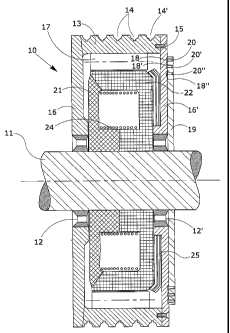Some of the information on this Web page has been provided by external sources. The Government of Canada is not responsible for the accuracy, reliability or currency of the information supplied by external sources. Users wishing to rely upon this information should consult directly with the source of the information. Content provided by external sources is not subject to official languages, privacy and accessibility requirements.
Any discrepancies in the text and image of the Claims and Abstract are due to differing posting times. Text of the Claims and Abstract are posted:
| (12) Patent: | (11) CA 2629630 |
|---|---|
| (54) English Title: | ELECTRIC MOTOR WITH A LOW NUMBER OF REVOLUTIONS, IN PARTICULAR TO DRIVE LIFTING DEVICES |
| (54) French Title: | MOTEUR ELECTRIQUE AVEC UN FAIBLE NOMBRE DE REVOLUTIONS, EN PARTICULIER POUR ENTRAINER DES DISPOSITIFS DE LEVAGE |
| Status: | Deemed expired |
| (51) International Patent Classification (IPC): |
|
|---|---|
| (72) Inventors : |
|
| (73) Owners : |
|
| (71) Applicants : |
|
| (74) Agent: | BERESKIN & PARR LLP/S.E.N.C.R.L.,S.R.L. |
| (74) Associate agent: | |
| (45) Issued: | 2011-07-26 |
| (86) PCT Filing Date: | 2007-03-19 |
| (87) Open to Public Inspection: | 2007-11-15 |
| Examination requested: | 2008-04-23 |
| Availability of licence: | N/A |
| (25) Language of filing: | English |
| Patent Cooperation Treaty (PCT): | Yes |
|---|---|
| (86) PCT Filing Number: | PCT/IB2007/000669 |
| (87) International Publication Number: | WO2007/129150 |
| (85) National Entry: | 2008-04-21 |
| (30) Application Priority Data: | ||||||||||||
|---|---|---|---|---|---|---|---|---|---|---|---|---|
|
An electric motor (10) with a low number of revolutions comprises a rotor (17)
powered by three-phase alternating voltage, a series of magnets (21, 22) and a
coil forming a stator (24), in which the rotor (17) and the stator (24) have
the same number of magnetic poles. The stator (24) is powered with direct
voltage, and the frequency of the rotor voltage (17) is varied to obtain a
predetermined number of rpm of the motor and to vary the acceleration and
deceleration conditions of the motor. A thrust bearing opposes the effort of
the falling brake disc.
La présente invention concerne un moteur électrique (10) avec un faible nombre de révolutions qui comprend un rotor (17) alimenté par tension alternative triphasée, une série d'aimants (21, 22) et une bobine qui forme un stator (24), dans lequel le rotor (17) et le stator (24) possèdent le même nombre de pôles magnétiques. Le stator (24) est alimenté avec une tension directe, et la fréquence de la tension de rotor (17) est variée pour obtenir un nombre prédéterminé de tr/min du moteur et pour varier les conditions d'accélération et de décélération du moteur. Un palier de butée s'oppose à l'effort du disque de frein qui tombe.
Note: Claims are shown in the official language in which they were submitted.
Note: Descriptions are shown in the official language in which they were submitted.

For a clearer understanding of the status of the application/patent presented on this page, the site Disclaimer , as well as the definitions for Patent , Administrative Status , Maintenance Fee and Payment History should be consulted.
| Title | Date |
|---|---|
| Forecasted Issue Date | 2011-07-26 |
| (86) PCT Filing Date | 2007-03-19 |
| (87) PCT Publication Date | 2007-11-15 |
| (85) National Entry | 2008-04-21 |
| Examination Requested | 2008-04-23 |
| (45) Issued | 2011-07-26 |
| Deemed Expired | 2015-03-19 |
There is no abandonment history.
| Fee Type | Anniversary Year | Due Date | Amount Paid | Paid Date |
|---|---|---|---|---|
| Application Fee | $200.00 | 2008-04-21 | ||
| Request for Examination | $400.00 | 2008-04-23 | ||
| Maintenance Fee - Application - New Act | 2 | 2009-03-19 | $100.00 | 2009-02-20 |
| Maintenance Fee - Application - New Act | 3 | 2010-03-19 | $100.00 | 2010-02-08 |
| Maintenance Fee - Application - New Act | 4 | 2011-03-21 | $100.00 | 2011-02-10 |
| Final Fee | $300.00 | 2011-05-04 | ||
| Maintenance Fee - Patent - New Act | 5 | 2012-03-19 | $200.00 | 2012-02-23 |
| Maintenance Fee - Patent - New Act | 6 | 2013-03-19 | $200.00 | 2013-02-21 |
Note: Records showing the ownership history in alphabetical order.
| Current Owners on Record |
|---|
| JEZEK, GIORGIO |
| Past Owners on Record |
|---|
| None |